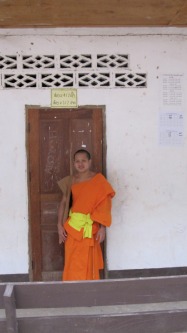 A chance encounter with a novice Buddhist monk while walking through the grounds of a monastery in Luang Prabang last week, was the catalyst for a new friendship as well as a chance to broaden my own horizons. A soft-spoken greeting of "hello" prompted me to stop and talk with Novice Sithong Sokphonexai. At age 17, he's been in the monastery since he was 13, when his family sent him there from their tiny village so that he could extend his rudimentary education. As the youngest of seven children, he's the first in their family to ever do so. After our initial meeting that day, I went back two other times to spend time talking with Novice Sithong. During our conversations I learned that he gets to see his family only one time each year, during July -- the rainy season -- when he spends a week helping them with planting. The trip home is a two-hour drive on one of the few paved roads in Laos, then a one hour ride in a tiny boat on a river that passes by the village. After school, in maybe two or three more years, Sithong would like to find a job in a local hotel, so he's working hard to improve his English, and is also studying Chinese. His days begin at 4AM when he gets up. At 6AM he walks to town -- along with hundreds of other monks in Luang Prabang -- for the morning alms procession (Tak Bat), where he gets food for the day. He eats only two meals. He then goes to school until the afternoon, when he comes back to his tiny room and studies. In the evening, he goes to the temple and prays before going to bed. Last Wednesday I bought him a new camera. When I went back to see him before I left Laos on Friday, he showed me the pictures that he'd already taken; there were beautiful photos of flowers, and one of a dog -called 'Lucky' -- and two of me that he'd taken at the top of Mt. Phousey, along with two that I'd taken of him while showing him how it worked that day. I find it interesting that I'm again exposed to Buddhism. My first exposure to Buddhism was in 1974, when I spent six weeks traveling around India. At age 23, I'd already left the Catholic church and was a member of the ultra-conservative Indianapolis Baptist Temple, with which I was becoming similarly disenchanted. I had no interest in exploring any other religion -- let alone something as 'strange and far away' as Buddhism seemed -- so I never learned much about it. (With regard to religion, my trip to India introduced me to Mahatma Gandhi, who became one of my heros. I remember reading something attributed to Gandhi: "There is no such thing as religion over-riding morality. Man, for instance, cannot be untruthful or cruel and claim to have God on his side." For me, at the time, cruelty and untruthfulness seemed to be core principles of the religions to which I'd been exposed during my life.) In my opinion, most of humanity has a spiritual hunger, regardless of whether any particular religion is practiced or not. Dissatisfied with the religion of their youth, many spend years on a journey that includes experimenting with and exploring various religious practices. To that end, a wonderful opportunity to explore and learn more about Buddhism begins on April 7th, when PBS begins airing their documentary "The Buddha, A Film" by the award-winning filmmaker David Grubin. Narrated by Richard Gere, with insight by His Holiness the Dalai Lama and other contemporary Buddhists, the documentary will present an excellent opportunity to learn more about meditation, Buddhist history, and how to incorporate the Buddha's teachings on compassion and mindfulness into our own daily lives. According to David Grubin, “Buddhism is growing more and more popular in America, but the Buddha himself remains a mysterious, exotic figure, the founder of a religion in a different key. The Buddha never claimed to be God, or his emissary on earth. He said only that in a world of unavoidable pain and suffering, he had found a serenity which others could find too. In our own bewildering times of violent change and spiritual confusion, the Buddha’s teachings have particular relevance.” I'm looking forward to watching the PBS documentary, and learning even more about my new friend's religion and way of life -- and to watching Sithong continue on his own life's journey. I wish him the very best, and look forward to helping him in any way I can. * Note: Here's an interesting Wall Street Journal blog post about Tiger Woods' recent return to Buddhism, his mother's religion. * Photos: Novice Sithong in front of his monastery classroom door, and at the steps to the Mt. Phousey temple at the top of Mt Phousey, Luang Prabang
2 Comments
 Getting up at 5AM is never easy for me, but I was eager to experience a ritual as old as the Buddha himself. The morning alms procession (Tak Bat) is a living Buddhist tradition that has great meaning for the people of Luang Prabang. Beginning around 6AM every day, hundreds of Monks file out of Luang Prabang's monasteries in lines resembling threads of saffron swaying in the breeze. Townsfolk and tourists take their places on one side of various streets throughout the city, rice baskets in hand, to repeat, yet again, the ancient custom of giving alms. I was privileged to take part in this truly moving experience, along with Brad and Maggie, on the morning of March 8, 2010. Kneeling on small mats, no one wears shoes, the stillness of this silent procession at daybreak is broken only by strutting, crowing roosters, the scuffing of bare feet and the clicking of cameras as the monks quietly pass by. The alms basket of each monk receives a ball of sticky rice from each person along the route. In addition to sticky rice, bananas and other foods may also be given -- along with flowers. Alms giving results in the monks receiving daily sustenance and the givers gaining merit, which it is believed will bring them happiness, a peaceful life and the strength to overcome any obstacles or misfortune that they might encounter. I was genuinely moved by the piety of givers and receivers and the nearly perfect silence of the procession. It seemed that, for a brief flash of time, the world stood still and I was suspended in time in a place that could be called Shangri-La. Note: Video and photos were taken the morning of March 8, 2010. Luang Prabang, Laos |
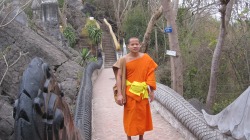

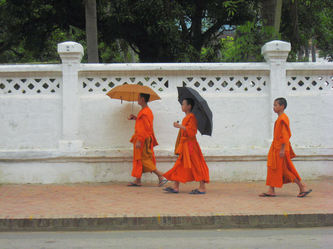
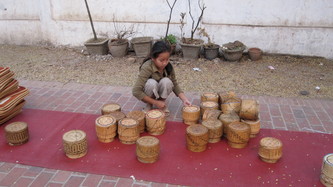

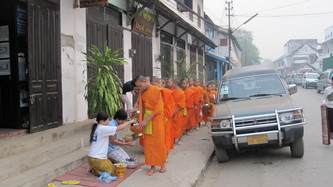
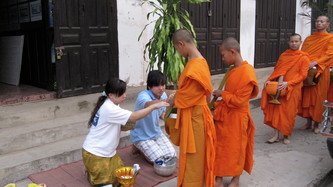
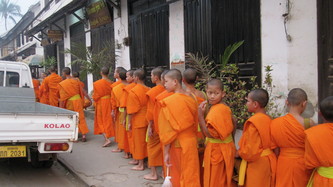
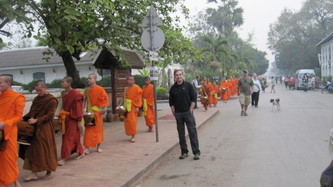
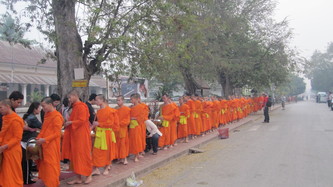
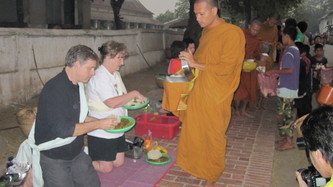
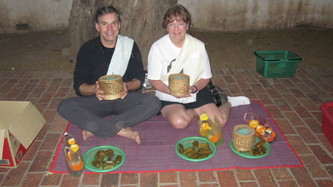
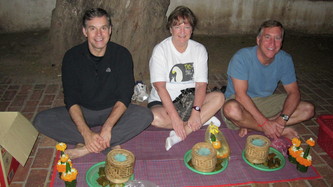
 RSS Feed
RSS Feed





